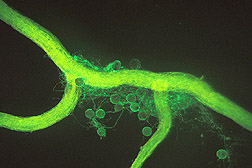This page has been archived and is being provided for reference purposes only. The page is no longer being updated, and therefore, links on the page may be invalid.
|
|
|
|
Glomalin is Key to Locking up Soil Carbon
By Don ComisJune 17, 2008
A soil constituent known as glomalin provides a secure vault for the world's soil carbon. That’s according to Kristine Nichols, a microbiologist at the Agricultural Research Service (ARS) Northern Great Plains Research Laboratory in Mandan, N.D.
Glomalin is a sticky substance secreted by threadlike fungal structures called hyphae that funnel nutrients and water to plant roots. Glomalin acts like little globs of chewing gum on strings or strands of plant roots and the fungal hyphae. Into this sticky “string bag” fall the sand, silt and clay particles that make up soil, along with plant debris and other carbon-containing organic matter. The sand, silt and clay stick to the glomalin, starting aggregate formation, a major step in soil creation.
On the surface of soil aggregates, glomalin forms a lattice-like waxy coating to keep water from flowing rapidly into the aggregate and washing away everything, including the carbon. As the builder of the formation “bag” for soil, glomalin is vital globally to soil building, productivity and sustainability, as well as to carbon storage.
Nichols uses glomalin measurements to gauge which farming or rangeland practices work best for storing carbon. Since glomalin levels can reflect how much carbon each practice is storing, they could be used in conjunction with carbon credit trading programs.
In studies on cropland, Nichols has found that both tilling and leaving land idle—as is common in arid regions—lower glomalin levels by destroying living hyphal fungal networks. The networks need live roots and do better in undisturbed soil.
When glomalin binds with iron or other heavy metals, it can keep carbon from decomposing for up to 100 years. Even without heavy metals, glomalin stores carbon in the inner recesses of soil particles where only slow-acting microbes live. This carbon in organic matter is also saved, like a slow-release fertilizer, for later use by plants and hyphae.
Nichols began her career with ARS working with soil scientist Sara Wright, who first discovered and named glomalin in 1996. Wright has since retired.
Nichols will present these research results this afternoon at a public field day in Brookings, S.D.
ARS is a scientific research agency of the U.S. Department of Agriculture.

